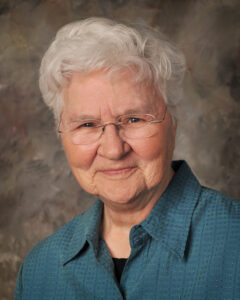Sister Miriam Schnoebelen
January 31, 1929 – January 19, 2023
 Sister Miriam Schnoebelen, 93, a Benedictine sister of Mount St. Scholastica, Atchison, Kansas, died Thursday, January 19, 2023, at the monastery. The vigil celebrating her life took place on February 10 in the monastery choir chapel. The Mass of Resurrection was held on February 11, with inurnment following in the monastery cemetery.
Sister Miriam Schnoebelen, 93, a Benedictine sister of Mount St. Scholastica, Atchison, Kansas, died Thursday, January 19, 2023, at the monastery. The vigil celebrating her life took place on February 10 in the monastery choir chapel. The Mass of Resurrection was held on February 11, with inurnment following in the monastery cemetery.
Sister Miriam was born in Mooreland, Oklahoma, on Jan. 31, 1929, the daughter of Claire Vincent and Mary Frances Knittel Schoenebelen. After her graduation from Mooreland High School, she enrolled at Benedictine Heights College in Guthrie, Oklahoma. In 1948, she joined the Benedictine community there, which later moved to Tulsa. In 1969, she co-founded the Sisters of Benedict in Piedmont, Oklahoma.
After teaching several years, she earned her M.S. in social work from St. Louis University and served in a variety of ministries: administrator of Benedictine Heights Hospital, social worker, counselor, pastoral associate, and founder of the Benedictine Peace House in Oklahoma City, where she set up a number of peace and justice programs. Her monastery joined with the sisters of Mount St. Scholastica in Atchison in 2010. She retained her passion for justice and peace all her life.
Sister Miriam was preceded in death by her parents, her sisters Dorothy Sullens and Elaine Nelsen, and brothers Bernard and Joseph Schnoebelen. She is survived by her brothers, Claude (Johnny) and Albert Schnoebelen, numerous nieces and nephews, and her monastic family. Becker-Dyer-Stanton Funeral Home is in charge of arrangements. Memorials may be sent to Mount St. Scholastica or made online at the Mount’s website.
Watch the Vigil.
Watch the Mass of Resurrection.
Reflection for the Vigil of Sister Miriam Schnoebelen
Genevieve Robinson, OSB | February 10, 2023
As the community gathers here this evening to celebrate the life of Sister Miriam Schnoebelen, we wish to express our sympathy to her brothers, nieces and nephews, friends, former community members, and Sisters Jan Futrell, Marie Ballman, and Joanne Yankauskis.
Sister Miriam left gentle requests in writing as to the readings that she wanted to be used for her vigil and Mass of Resurrection. Her suggestions for the vigil were Luke, the Book of Sirach, and the Letter of Paul to the Romans. All three readings reflect the life of Miriam.
As we reflect on the gospel of Luke, we listen to two of the disciples as they talk about Jesus on their way toward Emmaus. A stranger joins them. Unaware that it is Jesus, they are amazed that the man has not heard about the death of Jesus of Nazareth, whom they had hoped was the one who would redeem Israel. Instead, they noted, their hoped-for redeemer was handed over to Pilate to be condemned and crucified. To make matters worse, when they went to the tomb, his body was no longer there. Only after much conversation and the breaking of bread with the stranger who walked along with them do they recognize that the One who was with them IS Jesus, the Messiah. But, after eating with them and acknowledging who He is, Jesus disappears.
For Miriam, walking with Jesus was not what she initially did. Instead, to quote her: “From childhood I talked directly to God, i.e., [I] went right to the One considered to be at the top and didn’t mess around with go-betweens, except Mary occasionally.” Like the writer in Sirach, the young Miriam sought wisdom in her conversations with God. But in time, she changed her mind and did talk to Jesus, and in him she found much serenity, wisdom and hope.
Like Paul, Miriam believed that God would not disappoint her. She firmly believed that God’s love was poured into her heart and the Holy Spirit was with her always. Miriam was a prayerful woman. In her nineties she prayed for union with God, with Jesus. She had done so much. God had blessed her, and she was ready to join her departed loved ones.
Of her ninety plus years, a minor portion was spent here at Mount St. Scholastica. Among the many phases of her life, she acknowledged that few here at the Mount knew her. Ironically, she and I spent many days visiting and, one day, she handed me a folder of her biography and funeral requests and asked if I would give the reflection at her vigil. Needless to say, I was surprised by the request. But I also felt honored, and I promised to do my best.
So who was this woman that we wake tonight? Miriam grew up with four brothers and two sisters in the small rural community of Mooreland in northwest Oklahoma during the dust bowl and World War II. Family was extremely important to her. Miriam was a gentle woman, a prayerful woman, a woman with an abundance of talents. In Oklahoma, her service to many is legend. She loved her time working with the poor. She is remembered as a teacher who participated in extracurricular activities, such as being a basketball coach, yes, a coach, and a choir director. She served as a medical records librarian. She also was a family and marriage counselor and a community organizer. Even though she yearned to be a hermit, many enjoyed her time in the ministry of “clowning” – in costume or without – something most of us here never witnessed. She served as the first director of Benedictine Peace House, which assisted Central American immigrants. She was a good listener.
Peace and justice issues were extremely important to Miriam. She commented that much of her strength emanated from a passion for non-violence, peace and justice modeled by her mother and father. Thus, justice and peace were important components in her life. In addition to her parents, some of her heroes were the prophet Habbakuk, Mohandas Gandhi, Dorothy Day, Catherine DeHouck, Mary Charles Brice, and a collection of Benedictine women and men.
With that said, this evening, as we process to the dining room for refreshments and sharing, let us think of stories to share about Miriam that will help us better to know this woman of faith who, according to her, believed “like Habakkuk, she was taken up by the hair and was plopped down where God wanted her to be.” And as she said, she stayed “at the table in Oklahoma because I have been plopped down in the right place at the right time . . . and I could never have done that something bigger alone.” But after 90+ years, she finally heard the call from the One to whom she listened and with whom she yearned to be. And in the morning hours of January 19, she heard, “It is time to fold your tent, Miriam. Come,” and, she obeyed.
